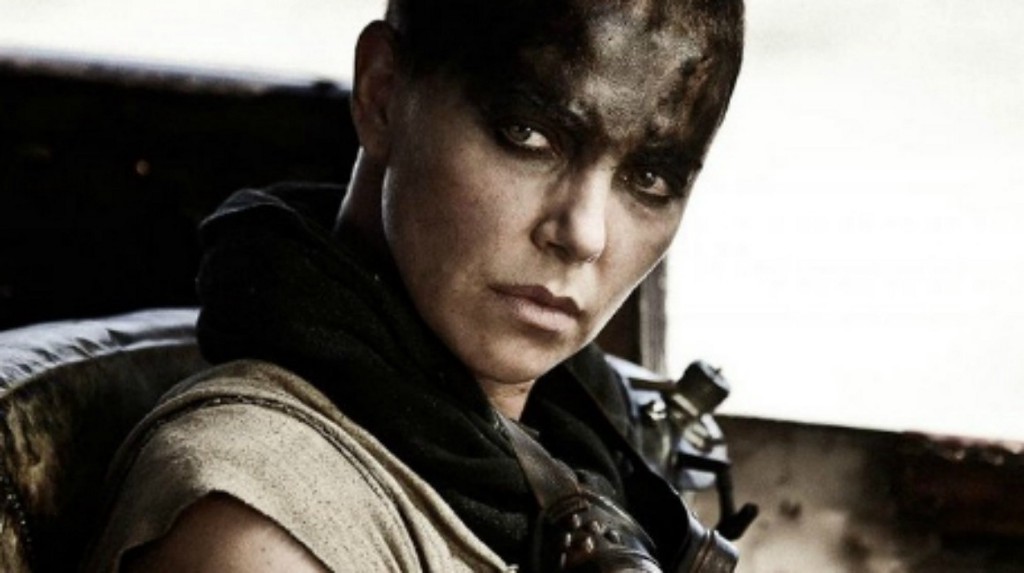
By Noah Berlatsky
If you had told fans of the Mad Max franchise circa-1986 that the fourth film in the series — up for an Academy Award at this Sunday’s Oscars ceremony — was going to be an explicitly feminist (or at least arguably feminist) narrative about overthrowing the patriarchy, said fans would probably have grunted and scratched their armpits in amused disbelief. Because whatever their virtues, the first three Mad Max films were, at best, only dimly interested in women.
Director George Miller’s series is devoted to manly men beating their manly chests while grunting and butting chests and cars and other manly bits. Tough guy, glowering-cowboy-biker-machismo and leather, and guns, and brutal death in gladiatorial combat: That’s what Mad Max was originally all about, not feminism.
The first film, in 1979, was particularly stark in its gleefully Neanderthal gender posturing. In a post-apocalypse that looked almost indistinguishable from the present, Mel Gibson as Max wanders through a right-wing nightmare in which evil thugs protected by oleaginous lawyers terrorize good neighborly folks and threaten the fabric of civil society. Max’s pure, sporadically spunky wife is casually offed to provide him with the requisite revenge motive. But the real energy of the film is in the male bonding, whether between Max and his shirtless, leather-pants-wearing police commander, or between the cops and their slavering biker gang antagonists. Men man the barricades of civilization to protect women from the barbaric manly hordes amidst the grim grinding of gear shifts, biceps, and gender stereotypes.
Mad Max 2: The Road Warrior (1981) and Mad Max: Beyond Thunderdome (1985) shuffle male archetypes a bit, but don’t really challenge them. With an increased budget, the post-apocalypse looks much more post-apocalyptic, and Max transforms from an agent of the crumbling but noble state into a wandering loner. He’s a shaggy cowboy Han Solo swaggering into Dodge to declare his contempt for the sissified city folk before offering to die for them in an apotheosis of revving engines and gunfire. Women and children look up to Max and his giant swinging guns, and he laconically acknowledges their tribute by performing uber-competence and uber-violence. Then he heads back out into the desert: a man alone with only his penis and his car for companionship.
There are, though, perhaps a few foreshadowings of Fury Road in the earlier films — especially in the character of Aunt Entity in Thunderdome. Entity, played by an electric if under-utilized Tina Turner, is the boss of Bartertown, a precarious community of thieves and toughs. She has shakily reinstated the order which Max brutally but unsuccessfully defended in the first film.
“You think I don’t know the law? Wasn’t it me who wrote it?” she declares. Though she’s the villain of the piece, her motives seem admirable, more or less. She wants to preserve civilization, and build a functional community out of pig shit — the fuel which Bartertown uses for power. Entity isn’t exactly a feminist hero, but she’s still a precursor of Charlize Theron’s Furiosa, who overthrows the evil patriarch Immortan Joe in order to establish a better, female-led society.
In fact, when you look at Entity, the gap between the women in the earlier Mad Max films and Furiosa doesn’t seem so great after all. Perhaps Furiosa isn’t a rejection of the Mad Max series’ gender roles so much as a re-crystallization of them. From the first film to the last, women are figured as a force for civilization; as Aunty suggests, they are the ones on whom the law is built. In the first movie, Max is a policeman — but only as long as his wife Jessie (Joanne Samuel) is at home, tending to the baby and providing an oasis of 1950s idyllic home life to ground her man. Once she’s gone, Max turns from lawgiver into vigilante outsider, riding sweatily towards isolation and death.

The various communities into which Max drifts in the second and third films are also anchored by women and the associated children. Men are sometimes in charge — but all-male communities in these films tend to be gangs, not civilizations. Notably in Beyond Thunderdome, when Max stumbles into a group of kids reminiscent of Peter Pan’s Lost Boys, the children aren’t all boys. Instead, the leader, and the person who preserves the oral traditions, is Savannah Nix (Helen Buday). At the conclusion of the film, Savannah has found an abandoned city and has figured out how to generate electricity, to light many of the buildings at night. They keep them on, she says, in case Max, or others, should return — a beacon of civilization for all those lost men, traipsing about the desert as men do.
Fury Road is in some ways a radical break with Mad Max past. It puts a woman at the center of the story, and that woman gets to overthrow the patriarchal law giver. It’s almost as if Jessie from the first movie kneed Max (rather than the bad guy biker) in the crotch and stole his car.
But was Furiosa really that revolutionary? One could argue that the last film in the franchise could also be seen as a conservative embrace of Mad Max gender roles past. Women are civilization; Immortan Joe’s male patriarchy, in which women are enslaved and marginalized, is therefore innately uncivilized — an unsustainable innovation. Furiosa, in going from Max-like rebel to domestic leader, isn’t launching a progressive future so much as she’s turning the clock back.
The apocalypse rewinds, and the matriarchal civilization is reinstated. And Mad Max for his part fights for the women as he always does, before striding off toward the wilderness, where men are uncivilized men alone.
***
Lead image: flickr/Tom Blunt

